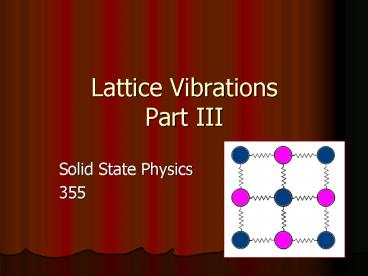Lattice Vibrations Part III PowerPoint PPT Presentation
1 / 27
Title: Lattice Vibrations Part III
1
Lattice VibrationsPart III
- Solid State Physics
- 355
2
Back to Dispersion Curves
- We know we can measure the phonon dispersion
curves - the dependence of the phonon frequencies
upon the wavevector q. - To calculate the heat capacity, we begin by
summing over all the energies of all the possible
phonon modes, multiplied by the Planck
Distribution.
Planck Distribution
sum over all wavevectors
sum over all polarizations
3
Density of States
4
Density of States One Dimension
determined by the dispersion relation
If the ends are fixed, what modes, or
wavelengths, are allowed?
5
Density of States One Dimension
of wavelengths wavelength wavevector
0.5 2L ?/L
1 L 2?/L
1.5 2L/3 3?/L
2 L/2 4?/L
6
Density of States One Dimension
To calculate the density of states, use
There is one mode per interval ? q ? / L with
allowed values...
So, the number of modes per unit range of q is L
/ ?.
7
Density of States One Dimension
There is one mode for each mobile atom.
To generalize this, go back to the
definition...the number of modes is the product
of the density of states and the frequency unit.
8
Density of States One Dimension
- Knowing the dispersion curve we can calculate the
group velocity, d?/dq. - Near the zone boundaries, the group velocity goes
to zero and the density of states goes to
infinity. This is called a singularity.
9
Periodic Boundary Conditions
- No fixed atoms just require that u(na) u(na
L). - This is the periodic condition.
- The solution for the displacements is
- The allowed q values are then,
10
Density of States 3 Dimensions
- Lets say we have a cube with sides of length L.
- Apply the periodic boundary condition for N3
primitive cells
11
Density of States 3 Dimensions
qz
There is one allowed value of q per volume
(2?/L3) in q space or allowed values of q per
unit volume of q space, for each polarization,
and for each branch. The total number of modes
for each polarization with wavevector less than q
is
qy
qx
12
Debye Model for Heat Capacity
Debye Approximation For small values of q, there
is a linear relationship ?vq, where v is the
speed of sound. ...true for lowest energies,
long wavelengths This will allow us to
calculate the density of states.
13
Debye Model for Heat Capacity
14
Debye Model for Heat Capacity
qD
15
Debye Model for Heat Capacity
16
Debye Model for Heat Capacity
Debye Temperature is related to 1. The
stiffness of the bonds between atoms 2. The
velocity of sound in a material, v 3. The
density of the material, because we can write
the Debye Temperature as
17
Debye Model for Heat Capacity
How did Debye do??
18
Debye Model for Heat Capacity
High T limit
19
Debye Model for Heat Capacity
Low T limit
20
Debye Model for Heat Capacity
Low T limit
21
Debye Model for Heat Capacity
22
Debye Model for Heat Capacity
- Einstein's oscillator treatment of specific heat
gave qualitative agreement with experiment and
gave the correct high temperature limit (the Law
of Dulong and Petit). - The quantitative fit to experiment was improved
by Debye's recognition that there was a maximum
number of modes of vibration in a solid. - He pictured the vibrations as standing wave modes
in the crystal, similar to the electromagnetic
modes in a cavity which successfully explained
blackbody radiation.
23
?D represents the maximum frequency of a normal
mode in this model. ?D is the energy level
spacing of the oscillator of maximum frequency
(or the maximum energy of a phonon). It is to be
expected that the quantum nature of the system
will continue to be evident as long as The
temperature in gives a rough
demarcation between quantum mechanical regime and
the classical regime for the lattice.
24
Typical Debye frequency (a) Typical speed of
sound in a solid 5103 m/s. A simple cubic
lattice, with side a 0.3 nm, gives ?D
51013 rad/s. (b) We could assume that kmax
?/a, and use the linear approximation to
get ?D vsound kmax 51013 rad/s. A
typical Debye temperature ?D 450 K Most
elemental solids have ?D somewhat below this.
25
(No Transcript)
26
Measuring Specific Heat Capacity
Differential scanning calorimetry (DSC) is a
relatively fast and reliable method for measuring
the enthalpy and heat capacity for a wide range
of materials. The temperature differential
between an empty pan and the pan containing the
sample is monitored while the furnace follows a
fixed rate of temperature increase/decrease. The
sample results are then compared with a known
material undergoing the same temperature
program.
27
Measuring Specific Heat Capacity

